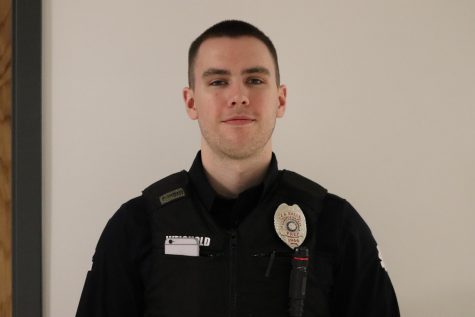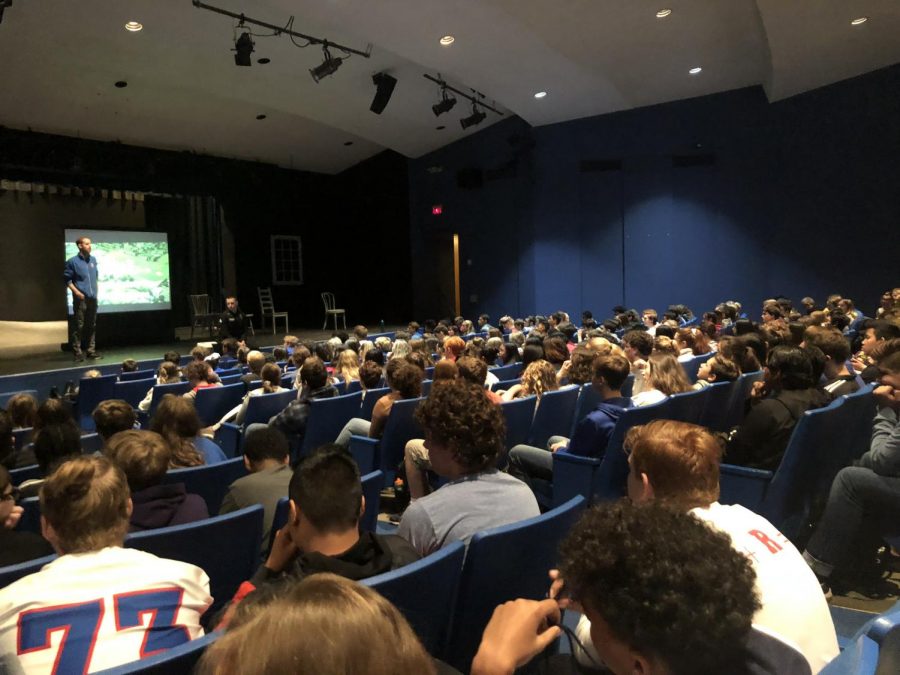Run, Hide, Fight: What Does This Mean for La Salle?
Students listening to Mr. Devine explain the Run, Hide, Fight protocol.
November 28, 2018
Ever since the horrendous shooting at Columbine in 1999, schools have adopted a variety of school-shooting protocols to help protect students and teachers in these traumatic situations. After years of following the well-known “lockdown” procedures, schools nationwide have gradually come to the realization that this approach to responding to school shootings simply isn’t working.
La Salle is now in the process of implementing a new nationwide standard for shooting protocols: Run, Hide, Fight.
What exactly is Run, Hide, Fight (RHF)? According to the Department of Homeland Security, the protocol adheres to a three-tier approach:
1) Run: Get as far away from the shooter as possible, and evacuate the building if you can.
2) Hide: If you cannot run, hide anywhere that creates some sort of cover from the shooter. If hiding in a classroom, barricade the door if possible.
3) Fight: If you can neither run nor hide, do whatever you can to fend off the shooter.
The biggest way that RHF differs from past systems is that decisions are entirely left up to the individual on how they want to respond to the situation. Students are given the power to choose to do whatever they think is best, given the circumstances at the moment. Simply stated, teachers have no jurisdiction over what students do in a school shooter situation.
“If you feel your best option is to run, don’t look to find an adult, just get the heck out of there,” said religious studies teacher Mrs. Jane Nitschke.
Following an active shooter situation, students and staff would need to be evacuated from the building and many students could be spread out across the surrounding area. This is where a “reunification plan” comes in.
According to Campus Security Officer Matthew Weichold, a reunification plan is “a coordinated plan on where [students/staff] are going so that… parents can pick up kids [and] loved ones can pick up the staff members.”
Since 2013, RHF has been the recommended protocol for schools to adopt, so why has it taken La Salle so long to integrate the national standard?
Over the past two years, Vice Principal of Student Life Mr. Brian Devine and Mr. Weichold have done extensive research looking into the RHF standard. In addition to meeting with the Clackamas County Sheriff’s Office, both of them attended a training in Eugene, which simulated an intense school shooting with an actor pretending to be an active shooter. Mr. Devine and Mr. Weichold have also spent several days developing the specifics of RHF for La Salle.

Since 2016, Campus Security Officer Matthew Weichold has been armed while on campus.
When asked to describe the simulation, Mr. Devine said, “It was pretty terrifying, but it was also eye-opening for me to see how much more empowered I felt utilizing that protocol versus just turning off the lights and hiding in the corner.”
Following this background work, the plan of RHF was pitched to Principal and President Mr. Andrew Kuffner by Mr. Devine, who then approved it for this year.
“We took about two years to kind of consider how to adopt this,” Mr. Devine said. “And I think at the end, we realized that we would actually be doing a disservice to the school community if we didn’t adopt this.”
At the start of the school year, the entire La Salle staff attended a training in which Mr. Devine and Mr. Weichold introduced RHF and showed a video of school children practicing the protocol.
“It was silent,” remarked Mrs. Nitschke, describing what the room was like during the training. “After the training, we were all sitting there just shell shocked because of the emotional upheaval. Watching little kids do [the protocol] really brings it home that there is no age barrier on this,” she said. “It can happen to anyone in any setting now, not just schools, but anywhere.”
In the spirit of being prepared, religious studies teacher Mr. Tom McLaughlin has created a plan of defense for his classroom and has even purchased a crowbar to safely open his classroom window if escape is necessary.

Mr. McLaughlin demonstrating how he plans to use the crowbar if needed.
Given the individualistic nature of RHF, Mr. Mac would also like to remind the La Salle community of our core values and to “look out for your neighbor.”
Each class has already received the same training that the staff attended at the beginning of the year, but this sensitive topic has triggered a range of responses, with many doubting the effectiveness of such a training.
“It kind of makes me feel, I don’t know how to explain, like, gross or sick,” senior Brigid Hanley said. “I don’t think any sort of drill can really prepare us for that versus an earthquake or fire… the chaos that can be caused by… an active shooter, and the panic and terror… you can’t simulate that.”
Others agree with the new protocol and think it will be extremely effective.
“I think it’s frankly about [time] that we’ve actually started to implement a protocol in which we are not cowering dogs in the corner,” senior Alex Ensroth said. “We are actually taking an active role in the safety of not only ourselves, but our peers.”
This sentiment has also been echoed by freshman Andrew Clair who said, “I think it made me feel like you had some power. I think it makes more sense that we’re taking this more dynamic approach.”
Although many see the protocol as a positive for the school, the new liberty provided by the protocol has come as a bit of a shock.
“I was a little surprised to hear that one of the options was fight,” sophomore Olivia Galbraith said. “I didn’t think that school administrators would tell you to fight like an adult with a gun… but I think that it’s a good option to have rather than just sitting there, defenseless in the classroom.”
When asked how he would respond in an active shooter situation, Ensroth said, “I think of all the possible places that I can hide and all the ways I could try and corral students, what words I can use that are specific and powerful and short to get the point across quickly enough to make sure that… everyone that I can help is safe.”
While not adhering to the three-tier approach, Clair said, “I’d probably try to organize something with… my classmates to see if we could… you know, ambush [the shooter] as [they were]… walking through a doorway or something like that.”
These presentations are not the last students will hear about RHF. According to Mr. Devine, the plan going forward is to run a “slow motion rehearsal.” This rehearsal would come in the form of an announcement over the speakers telling students and teachers that La Salle is running a drill, where the fictional shooter is located, and to engage RHF procedure.
“We would never surprise students with this,” Mr. Devine said. “We would talk about it, we would make sure students knew what we’re doing so that they felt prepared to kind of utilize that protocol.”
The goal of this practice would not be for kids to practice running or fighting, but rather to practice considering the options that RHF provides. “It’s more about the mindset that we want students to have: what would you do?” Mr. Devine concluded.
“[Shootings] can happen anywhere,” Mrs. Nitschke said. “If we plan for it here, even if it doesn’t happen here, maybe someday, students who are here will be somewhere else, and this training will help them save themselves.”






Caitlin Turker • Nov 29, 2018 at 9:10 am
I agree with how important this is because school shootings are a no laughing matter. When I hear about a school shooting all I can think of are those who lost someone. At night I pray for the families who have lost a love one that wasn’t in a school shooting, just a shooting. People use guns to protect themselves but we need to think differently. I think that this idea of helping us learn about the shooting is a good thing is case we ever need it. Great article by the way! Love how inparational it it!